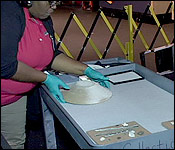
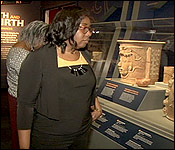

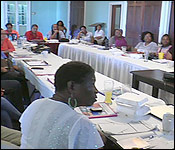 Over the past three years, we've brought you extensive coverage of the Maya Antiquities Road show that's traveled to five states in the US . Right now it's in Dallas, Texas. And overtime it travels between museums, conservators go to great pains to package all the pieces to withstand any shocks on the road. But what if, these delicate pieces do get damaged, do they just become write offs? American Conservator Newberry says they can actually be salvaged. Newberry held a workshop in Belize today on how to protect the collection and recover it after damage. Courtney Weatherburne was there and has more details.
Over the past three years, we've brought you extensive coverage of the Maya Antiquities Road show that's traveled to five states in the US . Right now it's in Dallas, Texas. And overtime it travels between museums, conservators go to great pains to package all the pieces to withstand any shocks on the road. But what if, these delicate pieces do get damaged, do they just become write offs? American Conservator Newberry says they can actually be salvaged. Newberry held a workshop in Belize today on how to protect the collection and recover it after damage. Courtney Weatherburne was there and has more details.
Courtney Weatherburne reporting
Artifacts are fragile, they have to be carefully handled and properly stored.
And when they are finally put out on display, they certainly can't be touched, sat on or tampered with.
But, interestingly, these objects can withstand a great deal of stress. It isn't the ideal situation but in the event of a hurricane or flood and fire, these fragile items can still be preserved.
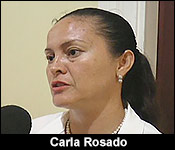 Carla Rosado, Marketing and Membership Officer, Museum of Belize
Carla Rosado, Marketing and Membership Officer, Museum of Belize
"Participants will be able to protect their collection from damage as well as we are teaching how to recover damaged collections and to make sure they can save as much as possible from their collections."
And there are specific recovery techniques for different objects.
Rebecca Newberry, Conservator, Science Museum of Minnesota
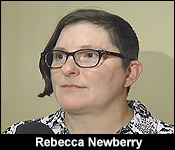 "So I am helping the people understand how the collections, what there made of so if you have something like let's say a glass bottle it is pretty strong, it can probably withstand being wet from the hurricane but it might break because it might get blown up against something you have to be careful when you handle it or if it is a book or a piece of paper it is going to be very fragile when it is wet but you can save it so the important thing is to respond to the disaster as fast as you can within 2 days and take that paper and actually freeze it if you can because that saves it from molding."
"So I am helping the people understand how the collections, what there made of so if you have something like let's say a glass bottle it is pretty strong, it can probably withstand being wet from the hurricane but it might break because it might get blown up against something you have to be careful when you handle it or if it is a book or a piece of paper it is going to be very fragile when it is wet but you can save it so the important thing is to respond to the disaster as fast as you can within 2 days and take that paper and actually freeze it if you can because that saves it from molding."
"You may lose somethings but it's amazing how many things you can save."
And during Hurricane Earl a few collections received water damage including a personal 22 album stamp collection, but with the freezing method, they were saved.
Marvin Pook, Conservator, Archives Department Belmopan
 "We had the opportunity to salvage a very valuable collection, which was a private stamp collection which was really damaged by..it was a Craig's collection aright so we spent like actually 3 to 4 months salvaging stamp by stamp."
"We had the opportunity to salvage a very valuable collection, which was a private stamp collection which was really damaged by..it was a Craig's collection aright so we spent like actually 3 to 4 months salvaging stamp by stamp."
According to Newberry, to make sure you don't lose your collection in the event of a natural disaster, you have to plan for it and one of those ways is to document all the items in the collection, so if the object is completely destroyed, a record of its existence can be still be preserved and carried on.
Rebecca Newberry, Conservator, Science Museum of Minnesota
"Part of good collections management at any museum is cataloging your collections so knowing what you have, knowing what it is, where it is from, where you got it and then also having a photograph of it, you know you can write a description of it, draw pictures but just describing what you have and keeping that record so you can write it on paper, you can also scan it and save it onto a computer."
The workshop continues tomorrow with a practical exercise on how to recover different items in a collection.



